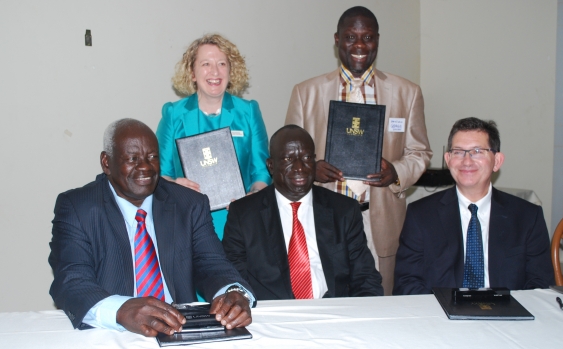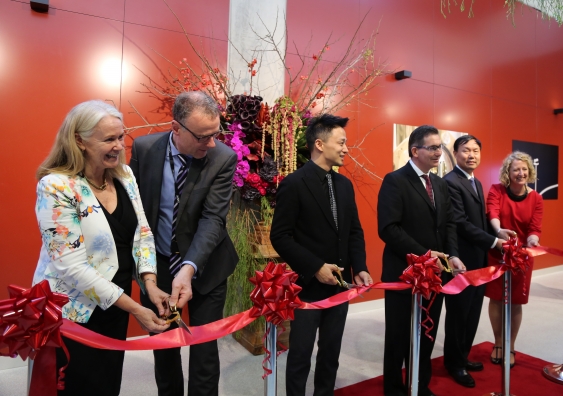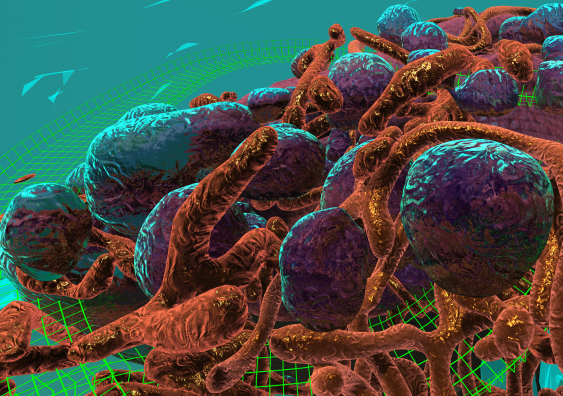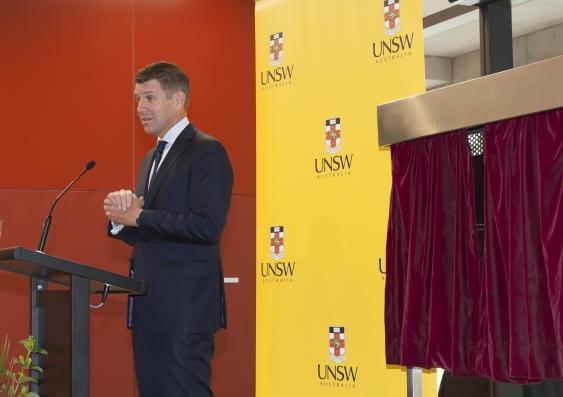UpFront: News in Brief
All UNSW's top news stories, from the opening of the Materials Science and Engineering Building, to the impact of delayed bipolar diagnosis and the UNSW–China $100m research partnership.
All UNSW's top news stories, from the opening of the Materials Science and Engineering Building, to the impact of delayed bipolar diagnosis and the UNSW–China $100m research partnership.

Crucial opportunities to manage bipolar disorder early are being lost because individuals are waiting an average of almost six years after the onset of the condition before diagnosis and treatment.
That is the key finding of a joint UNSW and Italian study published in the Canadian Journal of Psychiatry.
The meta-analysis of 9,415 patients from 27 studies, the largest of its kind, was led by clinical psychiatrist and Conjoint Professor Matthew Large from UNSW’s School of Psychiatry and his colleague, Dr Giovanni de Girolamo, from the St John of God Research Centre, Italy.
Many patients experience distressing and disruptive symptoms for many years before receiving proper treatment for bipolar disorder, which was previously known as manic depressive illness.
According to Large, a psychiatrist at Prince of Wales Hospital, the delay is often longer for young people because moodiness is sometimes mistaken by parents and doctors for the ups and downs of the teenage years, rather than being recognised as the emergence of bipolar disorder, which can be effectively treated with mood-stabilising medication.
“This is a lost opportunity, because the severity and frequency of episodes can be reduced with medication and other interventions,” Large said. “While some patients, particularly those who present with psychosis, probably do receive timely treatment, the diagnosis of the early phase of bipolar disorder can be difficult.
“This is because mental health clinicians are sometimes unable to distinguish the depressed phase of bipolar disorder from other types of depression.
“The diagnosis of bipolar disorder can also be missed because it relies on a detailed life history and corroborative information from carers and family, information that takes time and care to gather.”

UNSW's Professor Ian Jacobs (seated right) and Vice President, International Fiona Docherty celebrate the signing of the MoU with Gulu University's Vice-Chancellor Jack Pen-Mogi (seated left), Uganda's Commissioner for Higher Education Mr Robert Odok Oceng (centre) and Gulu University's Deputy Vice-Chancellor George Openjuru (standing).
President and Vice-Chancellor Ian Jacobs led a delegation from UNSW in August to launch a long-term collaboration with Gulu University, in Uganda’s far north. The visit also saw UNSW offering support for Uganda’s first undergraduate optometry degree program at Makerere University in Kampala. Uganda is one of three target zones, along with Myanmar and the South Pacific, where UNSW aims to improve the lives of one million people by 2025.
Speaking at the conference ‘Gulu – Creating Uganda’s Leading Sustainable City’, Professor Jacobs noted that even though the two universities were separated by a vast distance they shared a common goal – to create a better world.
Professor Jacobs noted the proposed collaboration with UNSW would see development programs for Gulu University academic staff, and visiting research fellowships (in both directions) in areas of shared interest such as mental health, justice, renewable energy and infectious diseases. There will also be staff training in library services, research infrastructure and communications, and exchange PhD scholarships.
Professor Jacobs said UNSW would also work with Gulu University to promote positive change across northern Uganda, linking the university, government and business, and supporting Gulu’s aim to become Uganda’s leading sustainable city.
He observed how the best universities did not stop at the edge of campus, but moved into the surrounding society and were, in turn, influenced and shaped by the society and its needs.
Professor Jacobs said Uganda had seen much suffering since gaining independence in 1962, but it had also displayed remarkable strength – its people had overcome enormous challenges to reach a point of solid economic growth and relative stability.

Photo: Shutterstock
Australia is on track to eliminate hepatitis C in 10 years if record numbers of people living with the virus continue to seek and receive breakthrough antiviral treatment, according to a new analysis.
Data from the Kirby Institute at UNSW reveals that since new-generation hepatitis C cures were made available on the Pharmaceutical Benefits Schemes six months ago, 22,470 Australians have commenced treatment – a massive increase on the 2,000 to 3,000 people with hepatitis C treated annually before the listing.
Professor Greg Dore from the Kirby Institute said Australia is leading the world in the treatment of hepatitis C.
“This is the most rapid uptake of new treatments seen anywhere in the world, thanks to the unique approach Australia has taken in making these medicines available without restriction,” Professor Dore said.
“This represents a huge leap forward in public health. To put this into perspective, we are on track to cure more people with hepatitis C this year than in the past 20 years of interferon-therapy.”

From left, Professor Laura Poole-Warren, Professor Brian Boyle, Mr Chong Sun, Professor Ian Jacobs, Mr Zhihong Zhang and Ms Fiona Docherty at the official opening of the UNSW and Hangzhou Cable Joint Laboratory.
The new Torch Innovation Precinct at UNSW was officially launched in August and promises to inject at least $100 million of new research funding into Australia’s innovation system through new partnerships with Chinese companies.
The initiative is modelled on China’s highly successful program that co-locates businesses, universities and research organisations within dedicated science and technology parks to drive innovation. The UNSW Torch precinct is the first outside China.
UNSW President and Vice Chancellor Professor Ian Jacobs described it as “a shared platform for the future” which would significantly boost Australia’s research capacity through major investments from Chinese companies.
The first project in the Torch Precinct is a joint UNSW–Hangzhou Cable Joint Laboratory, which will develop a prototype of the graphene-based cable technology that overcomes electricity leakage that plagues conventional power grids. The new technology was invented by a UNSW research team led by materials scientist Professor Sean Li.
“The impact on the electricity sector, in terms of financial savings and environmental gains, would be profound,” the Director General of China’s Torch program, Zhihong Zhang, said of the potential of the new cables.
The commercialisation and application of the UNSW technology could save some 275 terrawatt hours of power a year across China alone – more than Australia’s entire annual energy consumption. A 10-metre-long prototype cable will be developed in Australia before a planned scale up to industrial trials and application in China.
“This is an example of great research crossing national boundaries,” said Professor Jacobs. “By accelerating our research in Sydney and scaling up by using the industrial capacity of China, then going out into the global market – this is a formidable partnership.”
An initial $30 million has been committed by eight Chinese companies to support UNSW-led research in advanced materials, biotechnology, energy, and environmental engineering, with a further $20 million worth of contracts expected to be signed in the coming months.

The mitochondria (orange) and endosomes(blue) inside a virtual breast cancer cell. photo John McGhee
Virtual reality is allowing scientists to walk through a breast cancer cell to observe the delivery of nanoparticle drugs, potentially speeding up the drug-design process.
Dr John McGhee, from UNSW Art & Design, has used high-resolution electron-microscope data to reconstruct a human breast cancer cell in three-dimensional computer graphics imagery.
Wearing virtual reality headsets scientists can literally walk through the ‘landscape’ of the cell to observe how nanoparticle drugs are absorbed.
“It’s as if you have shrunk down to nano size, to the height of 40 one-billionths of a metre and you are navigating the surface of the cell,” said McGhee. “You can literally walk around it and gather data.”
A collaboration with the ARC Centre of Excellence in Convergent Bio-Nano Science and Technology, Journey to the Centre of the Cell aims to speed up the science discovery process by improving understanding for medical researchers, students and patients.
It is the first time that data from an actual cell has been used to develop an interactive virtual reality model.
“To deliver a drug successfully the cell membrane needs to be penetrated,” said McGhee. “With this visualisation we can see if the drug gets past the tough cell surface, or whether the body automatically stops it. These are things that could never be observed in 2D.”
“A lot of scientific data doesn’t record movement so we had to make that leap for the researchers through augmentation while still keeping it scientifically accurate,” he said.

Premier Mike Baird. Photo Arunas Klupsas
The new home of Australia’s leading materials science and engineering research has been officially opened by the NSW Premier, Mike Baird.
“NSW is a world leader of innovation, science and engineering and this new state of the art building will be an important training ground for future leaders in these fields,” the Premier said of the significant addition to the UNSW Kensington campus.
President and Vice-Chancellor Professor Ian Jacobs said the $140 million building, which provides staff and students with exceptional research laboratories and flexible collaborative learning spaces, reinforces UNSW’s reputation.
“This amazing building has been designed for Australia’s highest ranked materials science school, which sits in the world’s top 50,” Professor Jacobs said. The building’s laboratories have been recognised with the Educational Architecture Award from the Australian Institute of Architects (NSW).
The new facility will be known as the Hilmer Building, in honour of former President and Vice-Chancellor Professor Fred Hilmer (2006–2015).
Emeritus Professor Hilmer said: “While I am honoured to have my name on such a significant building, this event is really recognition of the efforts of a committed and effective team that restored and enhanced the performance and reputation of UNSW.”
The Hilmer Building is home to a range of world-class research teams:

Photo: Shutterstock
Antipsychotic drugs are widely used in Australian nursing homes, despite minimal evidence supporting their effectiveness in managing symptoms of dementia. Studies showing the drugs increase the risk of stroke, cognitive decline and death have also been largely ignored.
Now UNSW Australia-led researchers have shown their use could be drastically reduced by creating awareness about these risks and training nursing staff to use alternative approaches to manage the symptoms of dementia.
The results of the innovative Dementia Collaborative Research Centre project were presented by UNSW Scientia Professor Henry Brodaty at the Alzheimer’s Association International Conference in Toronto, Canada.
The Halting Antipsychotic use in Long Term care project successfully eliminated regular antipsychotic medication from the treatment plans of 75% of study participants after six months, following an initial reduction of antipsychotics.
In the trial – which involved 140 residents across 23 NSW care facilities – de-prescribing was achieved through training long-term care facility nurses to recognise potential causes of behavioural and psychological symptoms of dementia BPSD) and encourage the use of non-pharmacological and person-centred approaches to managing BPSD, such as environmental modifications.
In Australia, up to 50% of long-term nursing home residents have a dementia-related illness, with many experiencing BPSD, including delusions, aggression and agitation. This poses major challenges for both residents and nursing facility staff.